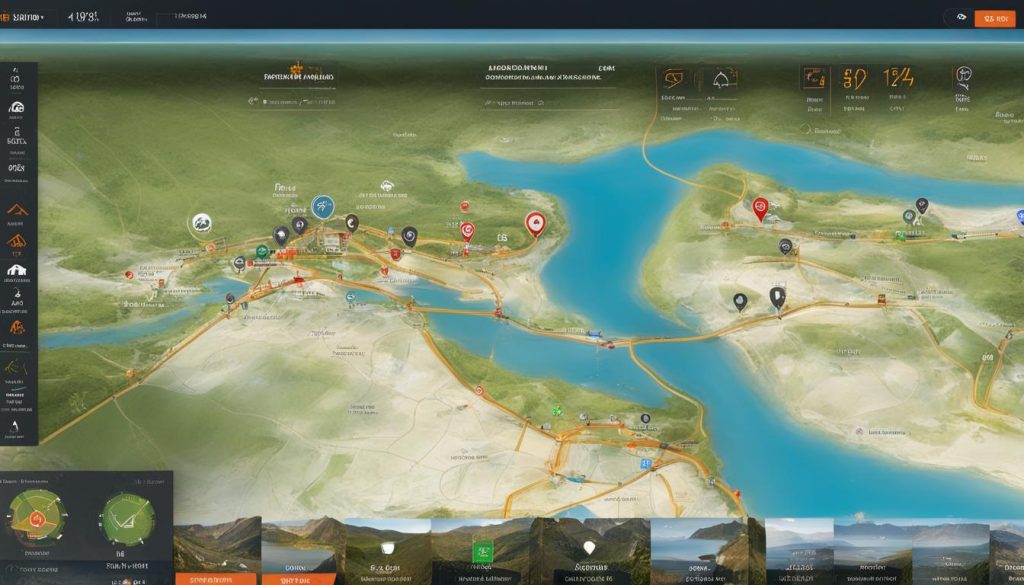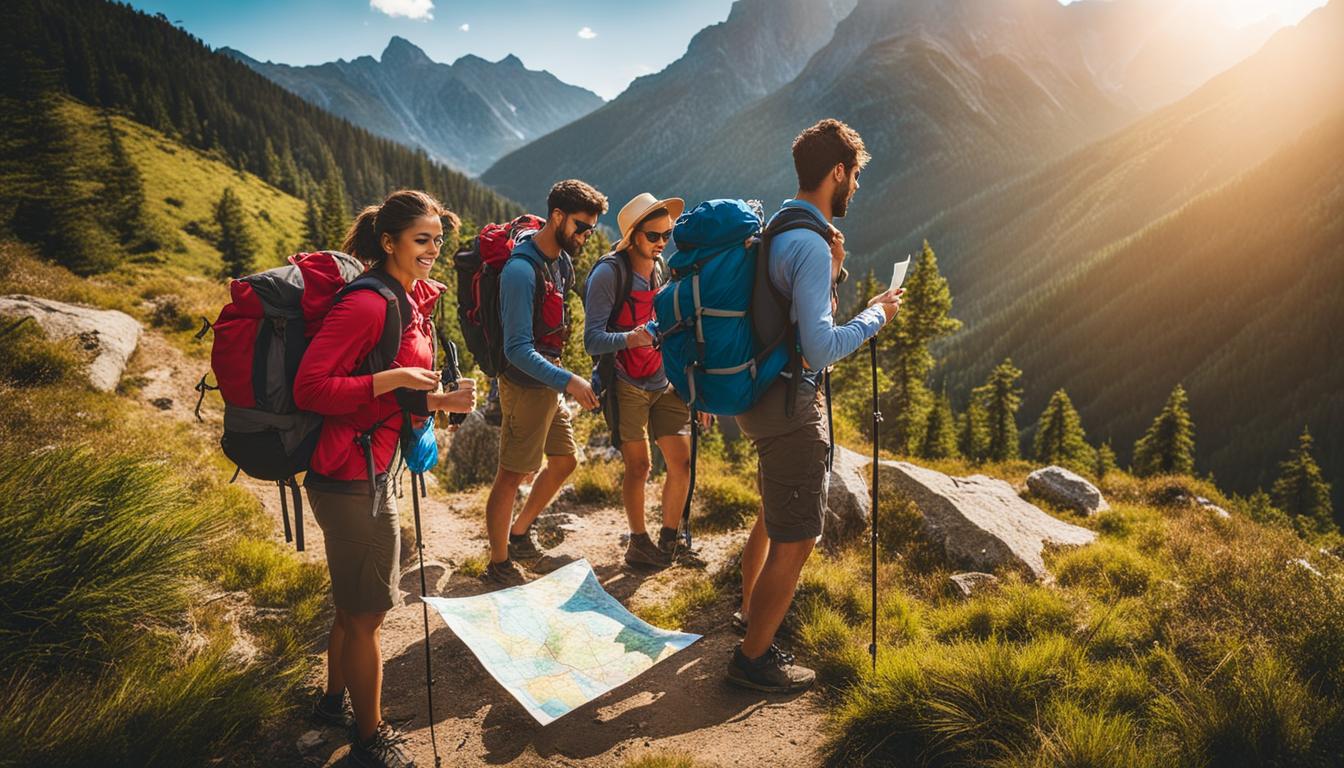When it comes to embarking on a road trip adventure, there’s nothing quite like the freedom of the open road. The thrill of discovering new destinations, the joy of breathtaking scenic routes, and the anticipation of the unknown make road trips an unforgettable experience.
However, planning a road trip requires careful consideration and organization. From selecting the most picturesque routes to ensuring you have all the essential items, meticulous planning is key to a successful adventure.
In this guide, I will provide you with valuable insights and practical tips on how to plan the ultimate road trip adventure. Whether you’re a seasoned traveler or embarking on your first road trip, this comprehensive guide will help you create an unforgettable journey.
Key Takeaways:
- Choose scenic routes to enhance your road trip experience.
- Consider the climate and terrain of the areas you’ll be exploring.
- Utilize online resources such as Google Maps, National Park Service, The Outbound Collection, and Outdoor Project for gathering information.
- Create a well-organized itinerary using tools like Google Docs to collaborate with your travel companions.
- Explore online resources such as Escape Campervans, Yelp, TripAdvisor, Google blog and image searches, and social media platforms for additional road trip planning information.
Choosing an Itinerary
When planning your road trip, it’s essential to carefully map out your itinerary. By considering factors such as scenic routes, travel planning, and road trip essentials, you can ensure a memorable and enjoyable adventure.
First and foremost, decide on your desired destination. Whether it’s a national park, a coastal town, or a vibrant city, marking potential destinations on a map will give you a visual overview of the mileage and drive times involved.
Instead of opting for the most direct route, consider taking the scenic route. This will allow you to immerse yourself in the awe-inspiring beauty of the journey, with picturesque landscapes and breathtaking vistas along the way.
Additionally, take into account the climate and terrain of the areas you plan to visit. Research the altitude and weather conditions to ensure you’re adequately prepared for any challenges and to make informed decisions about your route.
Remember, the key to a successful road trip is finding the perfect balance between exploration and organization.
Benefits of Choosing a Scenic Route
- Opportunity to experience breathtaking landscapes
- Chance to discover hidden gems and off-the-beaten-path attractions
- Enhanced sense of adventure and discovery
- More photo-worthy moments
Considerations for Climate and Terrain
| Factors | Why It Matters |
|---|---|
| Altitude | Influences weather conditions, temperature, and potential altitude sickness |
| Weather Conditions | Affects road conditions, visibility, and safety |
| Terrain | Determines the type of roads you’ll encounter, such as steep inclines, winding curves, or unpaved paths |
Collecting and Sharing Information
To stay organized during your road trip planning, I recommend using Google Docs to centralize all your ideas, recommendations, and trip details. Google Docs provides a convenient platform that can be accessed from any device, allowing you to seamlessly work on your itinerary wherever you are. Additionally, you can easily share the document with your travel companions for collaborative editing and real-time updates.
Start by creating a new Google Document and give it a meaningful title, such as “Road Trip Itinerary”. Begin with an information dump, jotting down all your thoughts, ideas, and notes related to your road trip. That could include potential destinations, attractions, activities, and any specific requirements or preferences you may have.
As you progress, consider pasting relevant pictures, website links, or any other valuable resources directly into the document. This way, you can have all the necessary information in one place without the hassle of switching between different tabs or documents.
Next, create a loose itinerary with the trip dates and a day-by-day breakdown of destinations, drive times, campsite reservations, points of interest, and activities. This will help you visualize the flow of your road trip and make it easier to allocate time for each activity or stop.
By using Google Docs, you can easily update and modify your itinerary as needed. Whether it’s changing your route, adding or removing destinations, or adjusting the schedule, everything can be done seamlessly. This collaborative approach ensures that all travel companions are on the same page and can contribute their ideas and suggestions.
Here’s an example of how your Google Docs itinerary might look:
Example Road Trip Itinerary
| Date | Destination | Drive Time | Campsite Reservation | Points of Interest | Activities |
|---|---|---|---|---|---|
| Day 1 | San Francisco, CA | — | — | Golden Gate Bridge, Fisherman’s Wharf | Explore the city, visit Alcatraz |
| Day 2 | Yosemite National Park, CA | 4 hours | Yes | Tunnel View, Half Dome, Glacier Point | Hiking, photography |
| Day 3 | Las Vegas, NV | 7 hours | No | The Strip, Hoover Dam | Gambling, entertainment |
| Day 4 | Grand Canyon National Park, AZ | 4 hours | Yes | South Rim, Desert View Point | Hiking, sunrise/sunset viewing |
By utilizing the collaborative features of Google Docs, you can streamline your road trip planning and ensure that you have all the essential information readily available. Remember to regularly save the document and share it with your fellow travelers for seamless collaboration.

Internet Planning Resources
When it comes to planning your road trip, the internet is your best friend. There is a wealth of online resources available that can help you gather all the information you need for a successful adventure. Whether it’s finding the best campgrounds, reading reviews on restaurants, or gaining inspiration from travel bloggers, there are countless websites and platforms that can assist you in your travel planning.
Escape Campervans
If you’re looking for road trip planning tips, packing advice, and itinerary suggestions, Escape Campervans’ website is a great place to start. They offer a comprehensive guide to help you plan and prepare for your journey, ensuring that you have all the road trip essentials you need for a memorable experience.
“A road trip is not just about the destination; it’s about the entire experience. Escape Campervans understands that and provides valuable resources to make your trip unforgettable.”
Yelp and TripAdvisor
When it comes to finding the best places to eat, stay, and explore along your road trip route, Yelp and TripAdvisor are go-to platforms. These websites provide user-generated reviews and ratings for restaurants, campgrounds, tour companies, and more. Reading other travelers’ experiences and recommendations can help you make informed decisions and discover hidden gems along the way.
Google Blog and Image Searches
If you’re looking for specific information from travel bloggers or visual inspiration for your road trip, Google blog and image searches can be invaluable. A simple search can lead you to travel blogs where you can find detailed itineraries, tips, and personal stories from fellow road trippers. Additionally, image searches can give you a glimpse of the stunning landscapes and attractions you can expect to encounter on your journey.
Social Media Platforms
Social media platforms like Instagram can be a great source of trip inspiration. Travelers from around the world share their road trip experiences, showcasing breathtaking scenery and must-visit destinations. By following travel-related hashtags or accounts, you can stay updated with the latest travel trends and discover new places to add to your itinerary.
Official Websites
Don’t forget to also check the official websites of organizations like the National Park Service, National Forest Service, and Bureau of Land Management. These websites provide valuable information on parks, camping, hiking, and more. They offer insights into entry fees, camping reservations, trail maps, weather conditions, and regulations to ensure your road trip is safe and enjoyable.
By utilizing these online resources, you can gather all the information you need to plan the road trip of a lifetime. From itinerary suggestions to reviews and recommendations, the internet is a powerful tool that can help you make the most of your adventure.

Route Planning
When it comes to planning your road trip, selecting the right routes is essential to ensure you have an unforgettable journey. Fortunately, there are several resources available to help you navigate your way to scenic destinations. Websites like US-Parks.com and Roadtrippers.com offer a variety of road trip route ideas that showcase the beauty of the landscapes you’ll encounter along the way. These platforms also allow you to add points of interest, ensuring you don’t miss any must-see attractions on your adventure.
One of the most reliable tools for road trip route planning is Google Maps. Not only does it provide accurate directions, but it also offers features like saving routes and marking favorite places. With Google Maps, you can easily visualize your journey, anticipate drive times, and make adjustments as needed.
When your road trip includes visits to national parks, the National Park Service website is a valuable resource that shouldn’t be overlooked. Here, you can find detailed information on entry fees, camping options, wildlife, maps, weather conditions, and more. Familiarize yourself with park regulations, popular trails, and seasonal closures before you hit the open road.
If you’re looking for accurate and waterproof trail maps for various national parks and trail systems, National Geographic Trail Maps is your go-to resource. These detailed maps provide valuable insights into topography, trailheads, and points of interest, allowing you to plan your hikes and outdoor adventures with confidence.
Another helpful resource for trail maps and descriptions is All Trails. This platform offers a vast collection of trails across the United States, complete with user reviews and ratings. With the companion phone app, you can access trail information even without an internet connection, ensuring you never miss a step on your journey.
| Resource | Description |
|---|---|
| US-Parks.com | A website offering road trip route ideas with the option to add points of interest. |
| Roadtrippers.com | A platform that provides road trip route ideas and allows users to add points of interest. |
| Google Maps | A reliable tool for planning and saving routes, as well as marking favorite places. |
| National Park Service website | A must-visit resource for information on entry fees, camping, maps, weather, and more. |
| National Geographic Trail Maps | Accurate and waterproof trail maps for various national parks and trail systems. |
| All Trails | A useful resource for trail maps and descriptions, with a companion phone app for offline use. |
By utilizing these route planning resources, you can create an itinerary that highlights the stunning scenic routes, takes you through captivating national parks, and allows you to explore the great outdoors in a meaningful way.

Campground and Camping Resources
When planning your road trip, finding the perfect campgrounds and camping resources is essential for a memorable outdoor adventure. Whether you’re looking for free or paid campsites, there are online platforms that can help you discover the best spots across the country.
1. FreeCampsites.net
FreeCampsites.net is a valuable resource for budget-conscious travelers. The website provides maps, reviews, and recommendations for free campsites, allowing you to save on accommodation costs while enjoying the beauty of nature. With detailed information and user-generated content, you can find hidden gems and off-the-beaten-path locations for your road trip.
2. Hip Camp
If you’re seeking unique and private camping experiences, Hip Camp is the perfect platform for you. From private landowners and farmers to vineyards and ranches, Hip Camp offers a wide range of camping options. You can choose from waterfront campsites, glamping accommodations, or even campgrounds with on-site activities such as hiking, fishing, and kayaking.
3. Campendium
Campendium is a comprehensive camping resource that provides reviews, ratings, and photos of campgrounds across the United States. The website includes user-generated content and allows you to filter your search based on amenities, accessibility, and suitability for specific types of camping equipment. With Campendium, you can make informed decisions about where to pitch your tent or park your RV.
4. The Dyrt
The Dyrt is a popular platform for discovering and reviewing campgrounds. With a community of avid campers, you can access honest and helpful reviews, photos, and tips from fellow outdoor enthusiasts. The Dyrt also offers a convenient mobile app, allowing you to find campsites and plan your road trip on the go.
5. CampsitePhotos.com
Prior to booking a campsite, it’s helpful to have a visual representation of the available options. CampsitePhotos.com offers an extensive collection of photos for various campgrounds, giving you a better idea of the campsite layout, scenery, and overall ambiance. This resource allows you to choose campsites that best suit your preferences and requirements.
When embarking on your road trip adventure, don’t forget to check the Escape Campervans pantry for any leftover supplies and food. Additionally, it’s advisable to wait until after picking up the van to do your food shopping, ensuring you have enough space and suitable storage options for your camping provisions.
The Escape Campervan Experience
Escape Campervans offers a unique and adventurous way to experience road trips. Their vans are known for their colorful and cool designs and come with a comfortable setup, including a dining area that converts into a bed, a kitchenette with a sink and camp stove, and ample storage space.
The booking process is simple, and they have hubs in various locations throughout the US. The campervan experience provides a sense of freedom, intimacy, and personal growth, allowing you to explore freely, bond with your travel companions, and step out of your comfort zone.
Tips for the campervan experience include organizing the van before starting your trip, planning your route to stay within mileage limits, and taking advantage of dispersed camping options.
FAQ
How do I choose the best itinerary for my road trip?
Start by marking potential destinations on a map and consider taking the scenic route instead of the most direct one. Factor in the climate and terrain of the areas you plan to visit and check altitude and weather conditions before finalizing your route.
Where can I gather information for my road trip planning?
There are several online resources you can use, such as Google Maps, National Park Service, outdoor adventure websites like The Outbound Collection, and reviews from popular platforms like Yelp and TripAdvisor. Official websites like the National Park Service, National Forest Service, and Bureau of Land Management also provide valuable information on parks, camping, hiking, and more.
How can I stay organized during my road trip planning?
Use a Google Document to centralize all your ideas, recommendations, and trip details. Start with an information dump, and then create a loose itinerary with trip dates, destinations, drive times, campsite reservations, points of interest, and activities. This document can be easily accessed from any device and shared with your travel companions for collaborative editing.
What are some resources for route planning?
Websites like US-Parks.com and Roadtrippers.com offer road trip route ideas and the ability to add points of interest. Google Maps is a reliable tool for planning and saving routes, as well as marking favorite places. The National Park Service website is a must-visit for information on entry fees, camping, maps, weather, and more. National Geographic Trail Maps provide accurate and waterproof trail maps for various national parks and trail systems. All Trails is another useful resource for trail maps and descriptions.
Where can I find camping resources for my road trip?
Websites like FreeCampsites.net, Hip Camp, Campendium, and The Dyrt provide maps, reviews, and recommendations for free and paid campsites across the country. CampsitePhotos.com is a valuable resource for getting a visual representation of campsites before booking. Additionally, check the Escape Campervans pantry for leftover supplies and food, and wait to do your food shopping until after picking up the van.
What can I expect from the Escape Campervan experience?
Escape Campervans offers a unique and adventurous way to experience road trips. Their vans are known for their colorful and cool designs and come with a comfortable setup, including a dining area that converts into a bed, a kitchenette with a sink and camp stove, and ample storage space. The campervan experience provides a sense of freedom, intimacy, and personal growth, allowing you to explore freely, bond with your travel companions, and step out of your comfort zone.




